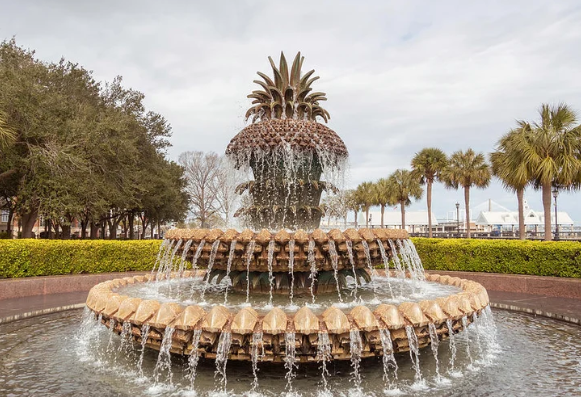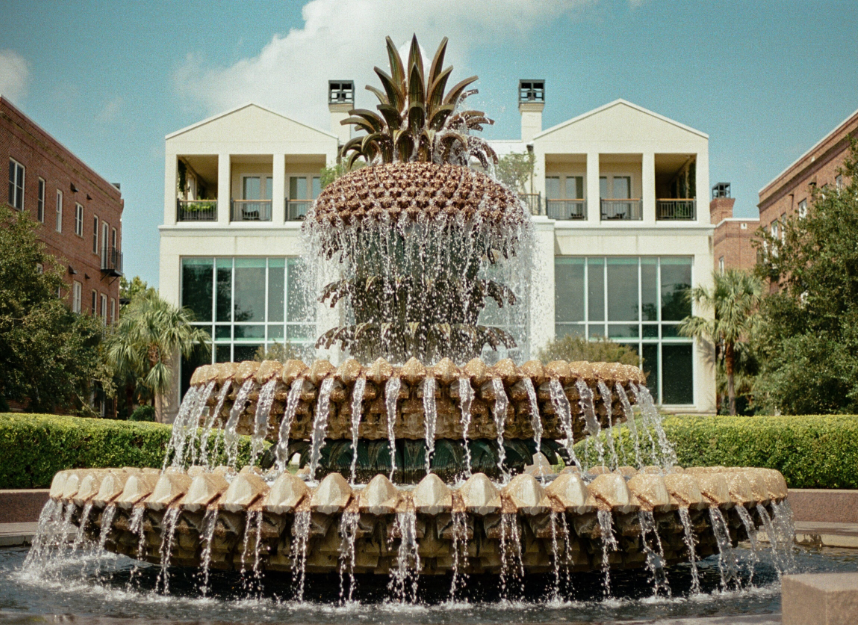Regarding iconic landmarks in Charleston, South Carolina, the Pineapple Fountain stands out as one of the city’s most beloved and recognizable symbols. This striking and beautifully crafted fountain, located in the heart of the historic Waterfront Park, serves as not only a refreshing oasis for visitors but also as a symbol of the rich history, culture, and hospitality that define Charleston.

Pineapple Fountain
In this article, we will explore the fascinating history of the Pineapple Fountain, its cultural significance, and what makes this charming landmark a must-visit attraction for anyone exploring Charleston.
The Birth of the Pineapple Fountain: A Touch of Southern Hospitality
In 1990, the city installed the Pineapple Fountain in Waterfront Park during a revitalization project to transform Charleston’s downtown waterfront area into a more accessible and attractive public space. Robert M., a well-known landscape architect, designed it. G. N. Smith says that someone made the fountain to be the center of the park and to give people a place to relax and have fun. The Pineapple Fountain, on the other hand, serves as much more than just a pretty water feature; it is also deeply ingrained in Charleston’s varied cultural and historical past.
Charleston regards the pineapple as a symbol of warmth, hospitality, and welcome, and it has been associated with Southern hospitality for a long time. This symbolism originates from the colonial era when settlers presented the rare and exotic pineapple as a gift to guests. Displaying a pineapple at a residence or business traditionally showed guests that hosts valued and respected them.
During the 18th and 19th centuries, Charleston was one of the most important port cities in the American South, and the pineapple became a symbol of wealth, generosity, and hospitality. You can still find pineapple motifs adorning historic homes, gates, and buildings throughout Charleston, a testament to the city’s enduring spirit of hospitality.
The city of Charleston wanted to create a new symbol of welcome for tourists from all over the world by incorporating pineapple into the design of the Pineapple Fountain.
Design and Features of the Pineapple Fountain
Visitors from near and far flock to the Pineapple Fountain, a striking and stunning piece of public art. Craftsmen construct the fountain with a series of intricate stone carvings, placing a large pineapple with three levels at the top as the focal point. The water fills the pineapple’s top and cascades down into a circular basin below, creating a peaceful atmosphere.
The design of the Pineapple Fountain is inspired by the natural beauty of Charleston and its surrounding Lowcountry region. The fountain’s smooth, curved lines evoke the shape of the palmetto tree, another emblem of South Carolina, while the cascading water represents the region’s many rivers and waterways. Lush greenery and blooming flowers also surround the fountain, creating a serene and picturesque setting that invites visitors to relax and enjoy the view.
One of the most unique features of the Pineapple Fountain is its interactive design. Unlike many other fountains that serve solely aesthetic purposes, the Pineapple Fountain invites visitors to dip their feet into the cool, refreshing water. The open and welcoming nature of the fountain makes it a favorite spot for families, children, and tourists who are looking to cool off and take in the beauty of the park.
The Pineapple Fountain offers a tranquil and inviting atmosphere that perfectly captures the spirit of Charleston, whether you’re strolling through the park, sitting on one of the nearby benches, or just taking in the view.

The Pineapple Fountain as a Symbol of Charleston
While the Pineapple Fountain is a beautiful and inviting landmark, it also carries a deeper cultural and historical significance for the city of Charleston. The fountain is more than just a decorative piece – it is a living symbol of the city’s values and traditions.
As was mentioned earlier, the pineapple has a long history of being associated with hospitality. This symbolism is essential to Charleston’s identity as a city that takes pride in being warm and welcoming. The Pineapple Fountain serves as a reminder of Charleston’s commitment to preserving its past while welcoming the future, as well as the significance of hospitality to the city’s history and culture.
The fountain also reflects Charleston’s historic waterfront charm and elegance. Charleston has a rich and storied history, with roots dating back to the 17th century, and the Pineapple Fountain is a modern addition to the city’s ongoing efforts to honor and celebrate its past. The fountain’s location in Waterfront Park, one of Charleston’s most beloved public spaces, further reinforces its connection to the city’s heritage and commitment to creating spaces that are accessible and welcoming to all.
Visiting the Pineapple Fountain: What You Need to Know
If you’re planning a visit to Charleston, a trip to Waterfront Park to see the Pineapple Fountain is an absolute must. Here’s everything you need to know to make the most of your visit:
1. Location and Accessibility
The Pineapple Fountain is located in the heart of Waterfront Park, a beautifully landscaped public park situated along the Cooper River in Charleston’s historic district. Numerous other popular Charleston attractions, such as the Battery, Rainbow Row, and The Market, are all within walking distance of the park. Whether you’re taking a guided tour of the city or exploring on your own, Waterfront Park is an ideal place to take a break, enjoy the scenery, and snap a few photos of the iconic fountain.
The park is great for both locals and tourists because it is open to the public and free to visit. It’s also an ideal spot for a leisurely walk or a picnic, with plenty of benches and shaded areas to relax and enjoy the surroundings.
2. Best Time to Visit
While the Pineapple Fountain is stunning at any time of day, there are certain times when it’s particularly magical. The early morning and late afternoon hours provide softer, more golden light, which creates a beautiful atmosphere for taking photos. If you prefer to avoid crowds, visiting during weekdays or in the early morning is a great option. Nevertheless, the fountain is a popular spot; therefore, be ready for visitors, particularly on weekends and during peak tourist seasons.
3. Interactive Experience
One of the most enjoyable aspects of the Pineapple Fountain is its interactive design. The fountain’s shallow basin makes it a great spot for families with young children because it lets people relax by dipping their feet in the cool water. However, it is essential to keep in mind that the fountain serves as a place of relaxation and enjoyment; therefore, please treat others with respect while enjoying the space.

The Pineapple Fountain: A Lasting Legacy
The Pineapple Fountain is a beloved symbol of Charleston’s charm, hospitality, and rich history. It serves as a testament to the city’s ability to blend tradition with modernity, creating a welcoming space that invites visitors to relax and reflect on the beauty of the Lowcountry.
Whether you’re a first-time visitor to Charleston or a longtime local, the Pineapple Fountain is a must-see attraction that captures the essence of the city. Its rich history, interactive design, and beautiful setting make it a true Charleston landmark that will continue to captivate visitors for generations to come.
Related Links:
- Top Attractions in Charleston, SC
- Charleston’s Historic Waterfront: A Visitor’s Guide
- Exploring Charleston’s Famous Pineapple Symbolism
- For Read More
